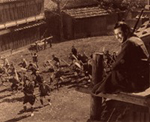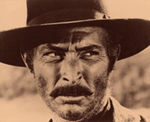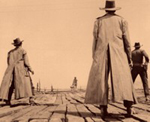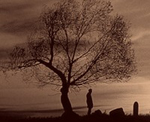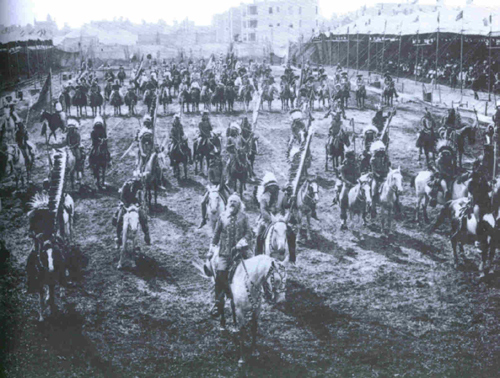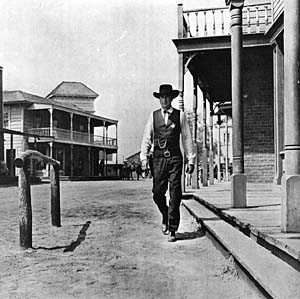Chapter I: The Western Myth
George Barnes in The Great Train Robbery (1903) Ever since Columbus's expedition of 1492, tales of the exotic New World had worked their way back to Europe, and with Sir Walter Raleigh's attempts to establish colonies in North America came the paintings of John White, depicting a vast, untouched Eden. By 1800, the Western frontier had expanded beyond the Appalachians, and with the Louisiana Purchase of 1803, the land west of the Mississippi was opened. The literary perception of a beautiful yet dangerous wilderness had been established in early captivity narratives of New England Puritans (tales of abduction by native American tribes, based on real events, but increasingly fictionalised), and furthered by the writings of such authors as Washington Irving, James Fenimore Cooper and Mark Twain. As America looked ever Westwards, the notion of a 'Frontier' grew - the very dividing line between savagery and civilisation. In 1823, President James Monroe`s 'Monroe Doctrine,' severed America`s historical links with Europe. Americans were to look inwards (and Westwards) for the blossoming of their nation. While the Atlantic Seaboard had been colonised by companies working for the British Crown, the vast spaces of the West were now intended to accommodate a brave new world of self-reliant settlers, ever pushing back the Frontier and driving the infant nation forward: 'Modern American democracy was born and cradled in the valley of the Mississippi'2 (Winston Churchill). The settlement of the West pushed on apace - native tribes were ejected from the Mississippi regions, and after the Alamo siege and subsequent wars with Mexico in 1836 and 1846-7, Texas, California, Arizona and New Mexico were ceded to the Union. The first nugget of gold was discovered in California in 1848, precipitating the gold-rush, and by 1860, five million white settlers, miners and ranchers were living west of the Mississippi. The 'cowboy' was no new phenomenon (originating from the Spanish vaquero, who herded cattle brought to the West Indies by Columbus and to the mainland by Hernando Cortes), but in the twenty years after the American Civil War (1865-85) the profession reached its zenith. During the War, the herds of cattle in Texas had been left to multiply to over six million longhorns as communications were cut to the East and the Mid-West. This semi-feral livestock therefore had to be driven north to Kansas railheads, such as Abilene, Dodge City and Ellsworth, for fattening and transporting along the Santa Fè, Union Pacific and Pacific railroads. The first trans-continental railway linked at Promontory Point, Utah, in 1869, and the rail routes became financial lifelines to cowboys, who blazed cattle trails such as the Sedalia, the Western and the Chisholm. Life on the trails was poorly paid and gruelling, and stampedes or attacks by native tribes were common. This, however, did not deter the imaginations of those in search of rugged adventure - a twenty seven year old Theodore Roosevelt viewed his time ranching in the Dakota Bad Lands as a romantic crusade, and his account - Ranch Life and the Hunting Trail (1889) - contributed to the popular perception of the cowboy as an intrepid folk hero. The 'Frontier' had disappeared by 1890 (officially constituting a region inhabited by between two and six people per square mile), but the glamorous myth of the cattle trails and rowdy cow-towns would long endure.
A camp on the trail The artists Frederic Remington (1861-1909) and Charles Russell (1864-1926) constructed an action-packed 'wild' West in their paintings of cavalry charges, saloon brawls and other motifs soon to be adopted by cinema. In the latter third of the nineteenth century, the imaginative 'West' developed in theatres (with Frank H. Murdoch`s Davy Crockett and the dramatic The Great Train Robbery) and in reams of 'dime' novels (comprising largely fictional adventure tales, and inflated biographies of emerging Western 'heroes' such as Wild Bill Hickok, Billy the Kid and Jesse James). The visual spectacle of theatre would play a major role in the blossoming of the Western myth - in the 1840`s, Phineas Barnum (later to open his 'Greatest Show on Earth') displayed groups of Iowa Indians in New York. This was to be a precursor to the lucrative show business of 'Buffalo Bill`s Wild West.' William Frederick Cody (1846-1917) merged his theatrical experience and Frontier scout background with dime novel action to create his touring troupe in 1883. With 'historical' re-enactments, real buffalo, and Indians (including, for a brief period, Sitting Bull himself), Buffalo Bill blazed the trail for cinema, which would deftly exploit the ready-made and highly popular theme with its ritualistic set of repetitious motifs.
'Buffalo Bill' Cody and the 'Wild West' show Thus, the movie Western was able to employ instantly recognisable signs to place the viewer swiftly in the visible world of the 'West,' and to aid expectation of plot and motivation. Richard Slotkin`s study of the 'Frontier Myth' explores the poetics of 'mythic space' in film - a pseudo-historical setting in which ideology is played out in evocative set pieces. Slotkin`s critique strikes to the heart of the genre - the Western is inherently intertextual, ever aware of its status as 'a mythic space populated by projective fantasies.'3 So self-referential did the genre become that by the mid twentieth century, a Western`s 'authenticity' was judged more by its relationship to previous films than to historical actuality. The movies followed Buffalo Bill`s lead in using authentic costume, and Thomas Ince`s Bison 101 Company made films adapting the Wild West show`s flamboyance to the Santa Monica landscape (moving the 'show' out of the arena) in such films as Custer`s Last Fight (1912) - a Cody-esque re-enactment. Historical accuracy was not going to win over the cinema-going masses, who recognised the iconography of the dime novel and the Wild West show, and as links to the 'real' Frontier faded, movie images became the West. By the time Bison 101 was merged with Universal and moved to Hollywood in 1915, Samuel Goldwyn and Cecil B. DeMille had already made The Squaw Man (1913) there, and the star system was growing. Broncho Billy Anderson had been the first (capitalising on his role in The Great Train Robbery), and he was succeeded by William S. Hart (a stickler for historical accuracy with a dead-pan persona) then Tom Mix (a rodeo star and entertainer who established the antithesis to Hart`s restrained romantic. He would later influence the all-singing Gene Autry and Roy Rogers who steered the genre down a very bizarre path). Mix merely had to ride into town once again to fill cinemas, such was his loyal following. Thankfully, however, others began to explore the Western`s 'epic' potential. James Cruz`s The Covered Wagon (1923) and John Ford`s The Iron Horse (1924) were milestones in chronicling the settlement of the West. By the time John Wayne debuted in Raoul Walsh`s The Big Trail (1930), the genre`s iconography was firmly established. Its ideology would be the subject of debate for decades to come. The 'West' was always an invention imbued with an ideology of 'progress.' Theodore Roosevelt`s 'rough rider' political spin betrayed 'an upper-class, eastern, monied consciousness that identified the "West" with American nationalism'4 (Clive Bush). The noble pioneering spirit and conquering of savagery amounts to an implicit justification of violence in the name of the Union. Indeed, Richard Slotkin asserts5 that, since a Western`s 'type' is determined by forms of conflict (cavalry charges, bar room brawls, Indian massacres, show-downs) the genre itself acts as a rationalising framework for 'necessary' violence. History may show us the Sand Creek and Wounded Knee massacres, the squalid conditions of Indian reservations, the economic brutality on the railroads and the abject poverty of Frontier life, but the mythical West displays redemptive violence, painful but required in the broad historical movement towards creating the greatest nation on earth. So, a 'hero' is invariably violent, yet displays a puritan restraint, unlike homicidal villains and the common Western symbol of excess - the town drunk. Like every successful myth, the Western affirms the dominant ideology, while reinventing itself to maintain its appeal, and the Western went through various guises after its fundamental iconography had been established. After the 1931 Great Depression, the Western went through a lean spell, with its chief ambassadors comprising 'B'-movies (assembly line 'Westerns by numbers') and light entertainment from the Tom Mix school of 'acting' (1935 saw the first Hopalong Cassidy film, while Gene Autry`s 'singing cowboy' was at his peak). Highly popular though these were, the myth was drifting away from any 'serious' studies of its dynamics. Cecil B. DeMille`s The Plainsman (1936) and Union Pacific (1939) were creditable attempts, but these were to be overshadowed by John Ford`s milestone return, and John Wayne`s redemption from 'B' Westerns - Stagecoach (1939). Ford`s film changed the Western for ever more, deftly merging pioneering zeal with domestic law and order issues (thus spanning the two chief topics of the Western at once). Stagecoach is a nod to the brief period, before telegraph wires and railtracks had spanned the continent, when the Wells Fargo and the Overland Mail Company ran stagecoaches to the Western towns, often at peril from highwaymen and reservation tribes. Ford`s vehicle is a microcosmic shake-up of various 'types' of people inhabiting the mythical West - a whore, a Southern gambler, a drunken doctor, a corrupt banker, an outlaw, a Kansas whiskey drummer and a well-bred officer`s wife. The vulnerable stagecoach emphasises their loneliness in the vast wilderness of Monument Valley on the Arizona/Utah border, and Apache attacks join a cavalry charge and a shoot out between warring families in a tour de force of mythic resuscitation of the genre. The post-war 1940s were decisive years in the history of the Western. Although Autry, Rogers et al enjoyed continued success, some of Hollywood`s most celebrated directors - Ford, Howard Hawks, Raoul Walsh - were engaging the genre with thoughtful and powerful studies. Ford`s penchant was for cerebral examinations of the dynamics of myth: My Darling Clementine (1946) offered a loose interpretation of the Wyatt Earp myth with the poetic imagery of Paradise Lost, and his 'cavalry trilogy' opened with Fort Apache (1948) - a study of a rash Custer figure leading his men to doom yet achieving a glorious apotheosis as a cavalry hero. Hawks`s Red River (1947) narrates the epic sweep of history transforming the 'Old West' into post Civil War reconstruction through a microcosmic relationship between John Wayne`s inflexible old-timer and Montgomery Clift`s rebellious youth on the cattle trails. In 1953, George Stevens produced what many consider to be the finest Western ever made - Shane. This sublime work merges a socio-historical study of the traumatic shift from pastoralism to small farming on the Frontier with self-conscious mythology. Alan Ladd`s Shane emerges from the Wyoming mountains like a supernatural embodiment of the wilderness and, after fulfilling his destiny, the lonesome, world-weary gunfighter blends seamlessly back into the countryside. Will Wright`s structural study, Sixguns and Society (1975), identifies Shane as the archetypal 'classical' Western, along with Anthony Mann`s The Far Country (1954), Henry Hathaway`s segment of the multi-directorial How the West was Won (1962), and many of the Westerns made between 1930 and 1955. Wright`s 'classical' structure narrates a lonesome hero's awkward entry into a society under threat from strong villains, and his subsequent triumph over them. Once the hero is accepted by civilisation, he finds he cannot fit in and leaves to resume his loneliness - a representative of 'Old West' wilderness, unable to adapt to the onset of civilisation. Wright also identifies the chief variation on this structure - the 'vengeance' plot, whereby the hero leaves society to pursue vengeance for a violation of 'natural' law, re-entering once it is achieved. The Ringo Kid in Stagecoach epitomises this variation, and Anthony Mann`s The Man From Laramie (1955) adds James Stewart`s neurotic persona to meditate on the ethics of vengeance. A highly influential
example of a vengeance Western is John Ford`s The Searchers (1956).
Ford`s tale of ex-Confederate Ethan Edwards (John Wayne) and his obsession
with revenge for his family`s murder by Comanches raises troubling ethical
questions. Monument Valley, this time in full Technicolor, again places
the protagonists in a vast wilderness, and Ethan`s extreme loneliness
is underlined by his bitter hatred of Comanches (to such an extent that
he wants to murder his abducted niece, Debbie, who has been 'corrupted'
by Chief Scar). Once Debbie is rescued, Ethan sees that he has no place
in the post-Civil War world of reconciliation, and walks away forlornly.
Wayne`s most ambiguous character raises the question of racism (especially
as he is accompanied by his part-Cherokee adopted nephew, Martin Pawley),
and Brian Henderson`s essay 'The Searchers: An American Dilemma'6
explores how this indicates the Western myth`s enduring ability to adapt
to contemporary society`s anxieties - Martin Pawley was white
in the original novel by Alan Lemay (1954), but by the time Ford was
working on his film, the Supreme Court was debating the policy of segregation
of Negroes. Ethan, the Southern racist, acts in a vengeance structure,
while purging America`s guilt for its past. His final exclusion
(subverting the vengeance tradition of re-entry into society) is mythopoetic
cinema at its most potent.
Kane (Gary Cooper) stands alone in High Noon (1952) The sixties certainly heralded a change in the Western. Henry Fonda, John Wayne, James Stewart, Joel McCrea and Randolph Scott were all entering their sixties, and ageing became a common theme. Once again, the death of the Western was proclaimed, as audiences became 'saddle sore'8 (Pauline Kael) with a tired genre. Nostalgia, however, had always been at the centre of the Western, and Sam Peckinpah`s Ride the High Country (1962), along with Ford`s The Man who Shot Liberty Valance (1962) lament the passing of the Old West in truly absorbing films. The latter also hints at Ford`s recognition that the myths of the West superseded reality very early on in the genre`s formation - when a journalist discovers that the legendary Ranse Stoddard (James Stewart) in fact did not shoot Liberty Valance, he refuses to print it: 'When the legend becomes fact, print the legend.' Debunking of mythology would become common in Hollywood throughout the 1960s. By this time, however, Hollywood was not the only distributor of the Western`s themes. The Japanese director Akira Kurosawa had adapted Western motifs and set-pieces in the making of his samurai films The Seven Samurai (1954) and Yojimbo (1961). Shane had been a hit in Japan and Kurosawa declared: 'Westerns have been made over and over again, and in the process a kind of grammar has evolved. I have learned from this grammar of the Western.'9 Once again, the genre was reinventing itself, and Sturges`s The Magnificent Seven was directly based on The Seven Samurai. Now, the Western was international: 'If a Western could be made from a Japanese movie with the plot virtually unchanged, then the genre belonged to everyone'10 (Buscombe). The novels of the German author Karl May (1842-1912) were made into successful European directed and produced Westerns (such as Der Schatz im Silbersee (1962)), revealing a large market for the genre east of the Atlantic. In late 1963, Sergio Leone went to the Arlecchio Cinema in Rome to see Yojimbo on the recommendation of his cameraman, Enzo Barboni. The ever-changing history of the Western genre was about to take another twist.
Footnotes1. Richard Slotkin, Gunfighter
Nation: The Myth of the Frontier in Twentieth Century America, (New
York: Harper Perennial, 1993), p.231. |

